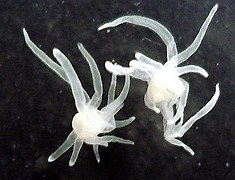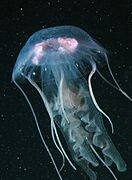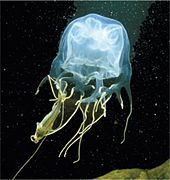Medusozoa
| Medusozoa Temporal range: Ediacaran – present,
| |
|---|---|

| |
| Pacific sea nettles, Chrysaora fuscescens | |
| Scientific classification | |
| Domain: | Eukaryota |
| Kingdom: | Animalia |
| Phylum: | Cnidaria |
| Subphylum: | Medusozoa |
| Classes[1] | |
| |
Medusozoa is a
Evolution
The phylum Cnidaria is widely accepted as being monophyletic and consisting of two clades, Anthozoa and Medusozoa. Anthozoa includes the classes Hexacorallia, the hard corals, and Octocorallia, the soft corals, as well as Ceriantharia, the tube-dwelling anemones. There is strong support for this group having been the first to branch off from the ancestral line.[6]
Medusozoa includes the classes
The affinities of the class
Animalia
|
|
Characteristics
Medusozoans differ from anthozoans in having a medusa stage in their life cycle. The basic pattern is medusa (usually the adult or sexual phase), planula larva, polyp, medusa. Symmetry is tetramerous, with parts in fours or multiples of four.[11] The mitochondrial DNA molecules are linear rather than circular as in anthozoans and almost all other animals.[12] The cnidae, the explosive cells characteristic of the Cnidaria and used in prey capture and defence, are of a single type, there being nematocysts but no spirocysts or ptychocysts.[4] In contrast, the anthozoan life cycle involves a planula larva which settles and becomes a sessile polyp, which is the adult or sexual phase.[11]
Diversity
There is considerable divergence from the basic life cycle pattern among medusozoans.[11]
Scyphozoa is the group commonly known as "true jellyfish" and occur in tropical, temperate and polar seas worldwide. Scyphozoans generally have planula larvae that develop into sessile polyps. These reproduce asexually, producing similar polyps by budding, and then either transform into medusae, or repeatedly bud medusae from their upper surface in a process known as strobilation.[4]
Cubozoa is a group commonly known as box jellyfish, that occur in tropical and warm temperate seas. They have cube-shaped, transparent medusae and are heavily-armed with venomous nematocysts. Cubozoans have planula larvae, which settle and develop into sessile polyps, which subsequently metamorphose into sexual medusae,[11] the oral end of each polyp changing into a medusa which separates and swims away.[4]
Staurozoa is a small group commonly known as stalked jellyfish. The animals remain attached to the substrate by a stalk at the opposite end from the mouth. Staurozoans can be regarded as large polyps that have partially differentiated into sexually mature medusae. These spawn gametes which develop into non-swimming planulae that crawl away to new locations.[4]
Hydrozoa is a large group of solitary and colonial cnidarians from both marine and freshwater environments worldwide. Hydrozoans exhibit the greatest variety of life cycles among medusozoans, with either the polyp or the medusa stage being missing in some groups.[4] In general, medusae are budded laterally from polyps, become mature and spawn, releasing gametes into the water. The planulae may settle to become polyps or continue living in the water column as medusae.[11]
-
An unidentifiedcubozoan
-
A colonial hydrozoan
References
- ^ Subphyla Medusozoa based on "The Taxonomicon – Taxon: Phylum Cnidaria". Universal Taxonomic Services. Archived from the original on 2007-09-29. Retrieved 2007-07-10.
- .
- ^ PMID 26465609.
- ^ ISBN 978-81-315-0104-7.)
{{cite book}}: CS1 maint: multiple names: authors list (link - PMC 5932825.
- ^ ISBN 978-3-11-037296-0.
- PMID 1356268.
- .
- PMID 37528711.
- PMID 18471296.
- ^ .
- PMID 22113796.











